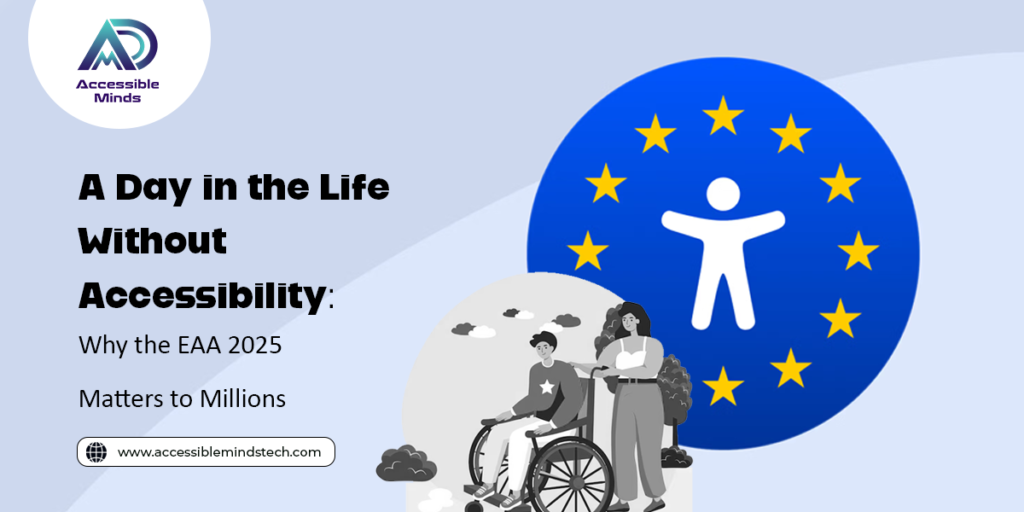Imagine waking up and being locked out of your own digital world. No access to online banking, job portals, booking apps, or even the news. This is a daily reality for millions of people with disabilities—and one that the European Accessibility Act (EAA) 2025 aims to change.
As the world moves increasingly online, web accessibility services have shifted from being an optional enhancement to an essential infrastructure. The EAA 2025 is Europe’s wake-up call—urging businesses to redesign their digital platforms for everyone, not just the able-bodied majority.
The Daily Digital Exclusion
Let’s walk through a typical day for someone affected by poor accessibility.
- Morning: Alex, a visually impaired professional, tries to check the weather using his screen reader. The site is overloaded with unlabeled images, and navigation is nearly impossible.
- Midday: He attempts to order lunch online. The checkout button? Hidden behind a non-keyboard-accessible modal.
- Afternoon: He joins a webinar, but the platform doesn’t support live captioning. He misses 70% of the content.
- Evening: He wants to pay bills, but the online payment gateway uses a CAPTCHA with no audio option.
What many take for granted becomes a constant source of frustration and exclusion. Now imagine millions like Alex—people with motor disabilities, cognitive challenges, hearing impairments—facing this every single day.
What is the European Accessibility Act (EAA) 2025?
The European Accessibility Act (EAA) is a directive that mandates a wide range of products and services in the EU to be accessible to people with disabilities by June 28, 2025. This includes websites, mobile apps, e-commerce platforms, ATMs, transport ticketing, and more.
The EAA draws from the UN Convention on the Rights of Persons with Disabilities, reinforcing the principle that digital access is not just good practice—it’s a human right.
Affected Businesses
- E-commerce sites
- Banking and insurance portals
- Transport and logistics
- Public sector websites
- Streaming and media services
Companies that fail to comply could face significant fines, lawsuits, and reputational damage. But beyond legal risks, there’s a moral imperative to act.
Why EAA 2025 Is a Game-Changer
1. Shifting Accessibility from Optional to Mandatory
Before EAA, digital accessibility was largely voluntary unless your site served government or educational institutions. EAA 2025 makes accessibility compliance non-negotiable.
2. Harmonization Across the EU
The Act brings uniformity across all EU states, replacing a patchwork of inconsistent national standards. This clarity helps businesses scale their digital operations efficiently.
3. Incentive to Invest in Accessibility-First Design
Accessible design is not a retrofit—it’s a mindset. The EAA pushes businesses to invest in Web Accessibility Services early in the design cycle, reducing technical debt and improving UX for everyone.
Web Accessibility Services: Your Compliance Toolkit
If you’re a business operating in the EU (or serving EU customers), you need to act now. Here’s how Web Accessibility Services can help:
Accessibility Audits
Professionals assess your website or app using both automated tools and manual testing by people with disabilities. These audits identify WCAG 2.2 violations and generate a prioritized remediation plan.
Remediation Services
Fixing issues such as missing alt text, poor color contrast, lack of keyboard navigation, improper focus management, and more—ensuring compliance with WCAG 2.1 Level AA, the standard referenced in the EAA.
Assistive Technology Testing
Verifying usability through screen readers (like NVDA and JAWS), voice input tools, and keyboard-only navigation to ensure real-world compatibility.
Ongoing Monitoring and Reporting
Accessibility is not a one-time fix. Continuous testing and user feedback loops are essential to remain compliant as your site evolves.
The ROI of Accessibility
While compliance is critical, businesses often underestimate the return on investment of inclusive design.
- Increased Market Reach: Over 100 million EU citizens live with some form of disability. Accessible platforms tap into this massive underserved market.
- Better SEO: Many accessibility best practices, like semantic HTML and text alternatives, align with search engine optimization.
- Enhanced User Experience: Accessibility improves usability for everyone—think of subtitles in noisy environments or keyboard shortcuts for power users.
- Reduced Legal Risk: Avoid costly lawsuits, negative publicity, and potential bans from EU markets.
What Happens If You Ignore the EAA?
Non-compliance can lead to:
- Heavy fines from national regulatory bodies
- Product recalls or removal from the EU market
- Legal class-action lawsuits
- Damage to brand reputation and consumer trust
The cost of doing nothing is far higher than the cost of compliance.
Your Next Steps
- Audit your digital assets now—websites, apps, PDFs, kiosks.
- Partner with experienced Web Accessibility Services providers.
- Train your dev and design teams in accessibility standards.
- Implement an accessibility statement and feedback mechanism.
- Monitor, test, and improve continuously.
Conclusion: Inclusion Is Innovation
Accessibility is not just about compliance—it’s about digital dignity. The EAA 2025 is a powerful catalyst driving the digital world toward greater equity and usability. Businesses that take action now won’t just avoid legal headaches—they’ll become leaders in inclusive innovation.
By investing in Web Accessibility Services, you’re not just checking boxes. You’re opening doors. For everyone.

